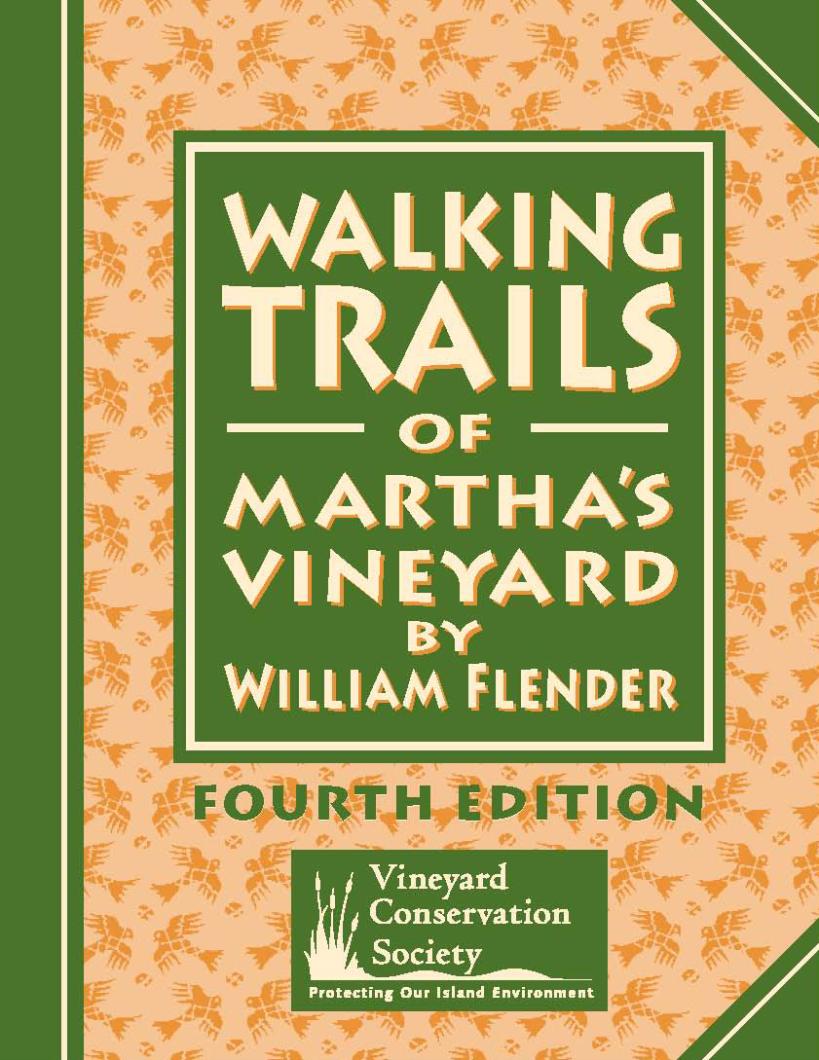By LIZ DURKEE
WALKINGS TRAIL OF MARTHA’S VINEYARD: The Comprehensive Pocket Guide to Island Trails, William Flender, Fourth Edition, Vineyard Conservation Society, Martha’s Vineyard, MA, 2010, $14.95, 117 PAGES.
A weatherproof, pocket-sized, fully-loaded guide to the Island’s walking trails. What a concept! It is such a good idea that the Vineyard Conservation Society has just published its fourth edition of Walking Trails of Martha’s Vineyard by William Flender.
If you are interested in befriending the deep corners of Martha’s Vineyard, the raw material of this community-in-the-sea that rests in and around the gorgeous coastline and picturesque villages — this guide is for you.
If you’re looking for a good hike, a new place to walk your dog or a fresh outdoor perspective — this is the perfect guide.
If you want your guests or renters to get a feel for the real Island — this guide is the key.
The subtitle says it all — Walking Trails is “the comprehensive pocket guide to Island trails,” those miles of paths that wander through forests and fields, along ponds and wooded streams, and among hills and meadows, cranberry bogs and rare grassland habitat. Some trails lead to beaches and water access for small boats. Some are inland, others coastal.
Walking, we know, is good for us, especially outdoors in the fresh air, sunshine and shade. But where can we walk safely and in peace, away from traffic and noise (and sometimes, let’s face it, hordes of other people)? Trails, byways, ancient ways, whatever you call them — those preserved, restored, meandering pathways are the answer, and they are about so much more than stretching our legs. They are a key to what links this place, this otherwise untethered piece of earth together. They remind us of why we live on and visit the Vineyard by connecting us — almost unwittingly through sight, sound, and smell — to the Island’s age-old landforms, its mossy undergrowth, its deep terrain. Walking the trails helps caramelize that often intangible life ingredient — a sense of place.
All four editions of Walking Trails, going back to 1996, have been written by William Flender, a former volunteer and intern at the Vineyard Conservation Society, beginning in his junior year of high school. According to the society’s executive director, Brendan O’Neill, “The idea of assembling in one book the maps of public trails on properties owned by the spectrum of Vineyard conservation landholders — nonprofit land trusts, the land bank, and the state DCR — was Will Flender’s idea.”
Descriptions of each of the 55 walks include individual color maps, directions, use guidelines and scenic highlights. There is an easy-to-read, full color, fold-out map designed by Martha’s Vineyard Commission cartographer Chris Seidel. Use guidelines include information on parking, bus routes, universal accessibility, rules on bikes, horses, dogs and hunting.
Great Rock Bight Preserve in Chilmark, for example, is a 28-acre parcel owned by the Martha’s Vineyard Land Bank. The use guidelines are these: “Bus accessible, no hunting, no dogs April 15 to June 16 (bird nesting season), bikes and horses prohibited from certain areas (shown on map), universal access.”
Mr. Flender’s descriptions of the properties are artful in both their brevity and depth of description. About Phillips Preserve in Tisbury, owned by the Sheriff’s Meadow Foundation, he writes: “This peaceful preserve offers walkers access to a previously inaccessible corner of the Island. The preserve features an open understory, which allows walkers to appreciate the gentle rolling topography of this property. Walkers are rewarded at the northern end with a view of Aunt Rhoda’s Pond which is actually a cove off the western edge of Lake Tashmoo. In the distance, the town beach at Herring Creek is visible. This is the only public property from which this part of Lake Tashmoo is visible.”
Mr. O’Neill notes that for this fourth edition trail routes have been updated as routes have changed and new trails have been added, and that Mr. Flender and his father, John, have done much of the hiking to check changes on the ground and test new routes.
The Vineyard Conservation Society’s goal in publishing the new edition, according to Mr. O’Neill, is twofold: “We seek to raise awareness of and respect for the Island’s many publicly-accessible, conserved properties. Secondly, we want to foster an appreciation of the hard work of the Island’s conservation organizations, working to protect land all over the Island.” He adds that the new edition includes a section on ancient ways and short walks as well as space for notes and observations.
In the introduction Mr. O’Neill writes that Walking Trails is “an indispensable resource for hikers, bikers, and birders,” as well as other lovers of the outdoors of Martha’s Vineyard.
And indeed it is. It combines two critical community values — conservation and public access — and folds them into a handy, user-friendly, reasonably-priced little package available to anyone who wants to take a peek at what rests beyond the Island’s beaten paths.







Comments (1)
Comments
Comment policy »